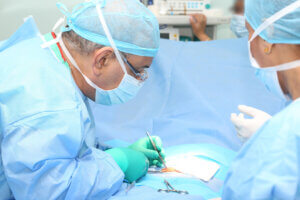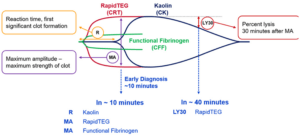Spinal Fusion
1. Prospective Randomized Study of Autologous Growth Factors in Lumbar Fusion: Clinical/Radiographic
Poster Presentation – 2005 Annual American Academy of Orthopaedic Surgeons Meeting
The clinical and radiographic data suggest that AGF combined with allograft carrier is an alternative to autograft in a lumbar interbody fusion model.
The purpose of the current study is to prospectively evaluate the radiographic and clinical effects of a platelet concentrate-allograft composite (Autologous Growth Factors) compared to autograft in anterior-posterior lumbar fusion.
Patients with 1 or 2 level DDD or spondylolisthesis were entered into the study. All patients underwent circumferential lumbar fusion with mesh cage interbody and posterior pedicle screw instrumentation. Patients were randomized to receive AGF combined with allograft cancellous bone (study group) or autograft ICBG (control) in the anterior interbody space. Postoperative follow-up was at standard intervals and included radiographic analysis: plain dynamic radiographs (at 12 and 24 months) and CT with reconstructions (6 months) to assess for fusion. An independent, blinded reviewer assessed fusion. Pre- and postoperative clinical data collection included VAS (0-10) back pain scores, Oswestry Disability Index and SF-36 outcomes.
37 patients were enrolled from 7/00 to 11/02: control group – 22 patients (age 41.4+/-8.0 / 14M 8F) and AGF study group 15 patients (age 40.3+/-7.5 / 10M 5F). Follow-up control 22.5+/-6.9 months and AGF 24.3+/-7.1. Surgical time and EBL was equivalent. CT reconstructions at 6 months revealed interbody fusion rate at 56% in both groups. Long-term radiographic follow-up revealed fusion rate of 89% AGF and 86% control (p=NS). Clinical outcomes of back pain showed similar decrease in VAS (AGF – -7.1 to 4.8) (control 7.5 to 5.3) as well as OSW and SF-36 scores in both groups (p=NS). No detrimental effects of blood sequestration or reinfusion were noted.
The potential advantages of platelet concentrates include enhancement of fusion, provision of a scaffold for bone incorporation and improved handling characteristics of graft material when added with thrombin. The clinical and radiographic data suggest that AGF combined with allograft carrier is an alternative to autograft in a lumbar interbody fusion model.
2. AUTOLOGOUS GROWTH FACTORS AND RESORBABLE POROUS CERAMIC WITHOUT BONE GRAFT FOR INSTRUMENTED POSTEROLATERAL LUMBAR FUSION
Ken L. Kurica, M.D., Kim Booton, R.N., James M. Giuffre, B.A.
Presented at the WorldSpine Meeting, 2003, Chicago, Illinois
Purpose of the Study: To perform a retrospective clinical and radiographic review of patients who underwent instrumented posterolateral lumbar fusion with or without interbody fusion, with Autologous Growth Factors (AGF) and resorbable porous ceramic (Pro Osteon 500R) on one side of the fusion, and autologous bone with demineralized bone matrix on the contralateral side.
Methods Used: Following informed consent, 20 patients indicated for instrumented posterolateral fusion with or without interbody fusion underwent the procedure(s) successfully. The mean age was 46.0 years (23-68). Primary diagnoses included internal disc disruption (13), spondylolisthesis (2), DDD (2), pseudarthrosis (2), and spinal stenosis (1). On one side of the posterolateral fusion, AGF, an osteoinductive mixture of growth factors which initiate new bone growth, processed from the patient’s blood perioperatively; were mixed with resorbable porous ceramic and placed in a standard posterolateral fashion following instrumentation with transpedicular fixation. Autologous bone taken from the iliac crest was mixed with DBM gel and placed on the contralateral side. There were 13 additional ALIFs and 2 additional PLIFs, all with titanium mesh cages filled with variable bone graft combinations. There were 2 one-level, 12 two-level, and 6 three-level fusions.
Summary of Findings: Minimum follow-up was 24 months (range 24-36). Postoperatively, there was 1 seroma which resolved. Posterior hardware was removed in 4 patients. Exploration of the fusion mass showed a solid fusion bilaterally with solid new bone growth on the AGF/resorbable porous ceramic sites. Radiographic evaluation showed no presence of pseudarthrosis or clefts in the fusion mass in the remaining 16 patients. Resorption of the resorbable porous ceramic and replacement with bone that was not present at the time of surgery, was noted in 100% (20/20). Solid fusion of the AGF and ceramic side was noted in 100% (20/20) and 100% (20/20) on the autograft and DBM side. All 15 patients with interbody fusion showed no radiolucencies as well as evidence of bridging osteophytes anterior to the cages. Mean Oswestry scores decreased 25.5% and mean pain (VAS) decreased 56.6% with 18/20 (90.0%) having a good clinical outcome. Narcotic drug use decreased 69% and 76.9% (10/13) returned to work, with 3 of 4 (75%) patients rated as disabled preoperatively, working at 24 months postop.
Relationship Between Findings and Existing Knowledge: A composite osteoinductive/osteoconductive bone graft replacement for instrumented posterolateral lumbar fusion is effective in producing new bone and a subsequent solid fusion in lieu of autograft or allograft by 24 months postop. The combination was not inhibited by smoking. This has not been show before in the literature.
Overall Significance of Findings: Based on these results, the combination of autologous growth factors with resorbable porous ceramic is an effective bone graft replacement for instrumented posterolateral lumbar fusion with or without interbody fusion. The osteoinductive AGF combined with the osteoconductive resorbable porous ceramic produced bone and a subsequent solid fusion. A randomized study without same-patient controls is warranted.




